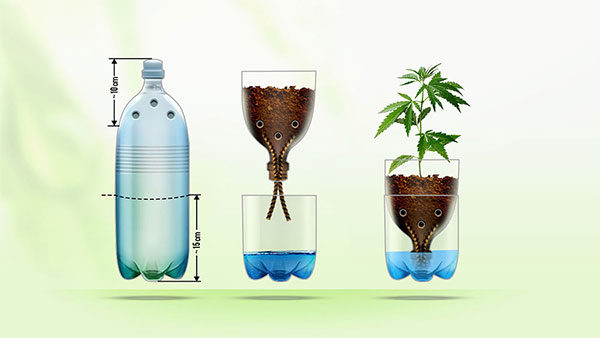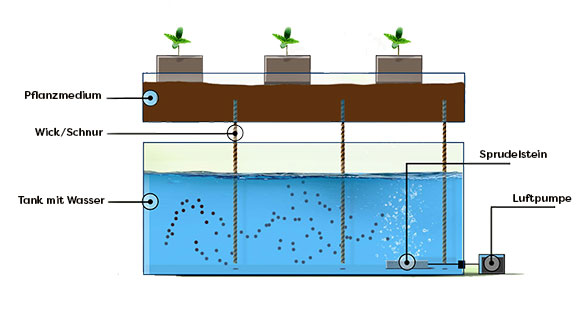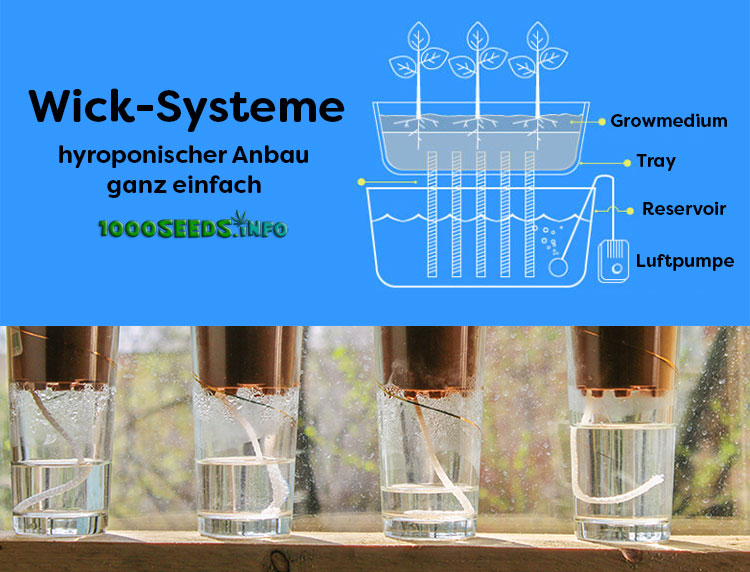Hydroponic Grow with Wick Systems
Wick systems are a simple and inexpensive way to grow your own hydroponics. Wick means wick and the systems have their name because a kind of wick/knit is used to transport water and nutrients into the plant container. There are different types of wick systems, but ultimately they always work according to the same principle: a wick hangs in the water and transports it into the planter above thanks to capillary action.
Wrap systems are especially popular with beginners because they are easy to set up and inexpensive. Only as much water and nutrients are used as the plant actually needs. Wick systems can be used both for cultivation on soil and for hydroponic cultivation.
A nylon wick/string is best suited as a "wick" because it cannot rot. Several "wicks" must be used per planting container (approx. 1 wick per litre of planting medium). If your growing space is quite warm or you have (too) much ventilation, it makes sense to use more wicks per planter.
Why use a wrapping system?
Wick systems use only as much water and nutrients as necessary and are easy to maintain and operate. Once the system is running well and everything is working, almost no effort is needed and the system or irrigation goes by itself.
They are also low-budget systems that you can make yourself without much effort, e.g. from a bottle that is cut into 2 halves as in the picture below.

Wick systems can be used when you are not at home and your plants still need to be supplied with water. In this way, plants can be watered for up to a week.
The size of the water reservoir under the planter determines how long the plants can be watered. If you use a Wick system, the plants and this system must be housed as usual in a closed environment, i.e. a grow box or a special grow room, with sufficient and suitable lighting. The humidity and temperature in the grow room are also important and decisive factors for a successful grow.
The advantages and disadvantages of wrapping systems
Like everything, wrapping systems have their advantages and disadvantages:
- Hydroponic cultivation requires more knowledge and understanding than soil cultivation. Too little or too much fertiliser can quickly lead to problems and result in weak plants.
- If the grow room and the accessories used are not clean, mould can develop. With large plants that need a lot of nutrients and water, low-budget home-built wicking systems can reach their limits.
- With wick systems, the nutrient supply and the exact amount of water provided can be less well controlled. The nutrient solution must be transported across the wick by capillary action. There may be too many or too few wicks in the planter, in which case the irrigation is not optimal and should be adjusted by adding or removing more wicks.
On the other hand, these systems have some advantages:
- Wrap systems are easy to set up and understand
- The effort and support is minimal
- They are cheap to buy and can also be built yourself.
- They are particularly suitable for small growing spaces
- They have only a few parts and hardly anything can break
How to build a winding system
If you want to build a system yourself, you need the following things:
- Wicks/cord e.g. irrigation tape with cabillary function from Autopot, or a thick cotton cord
- Plant pots
- A Trayin which you can position the plants
- A planting medium e.g. Clay Pepples Vermiculite, Perlite, Rockwool, Coco
- A nutrient tank: this should be dark so that no light can reach the water.
- Fertiliser for cannabis plants
The wicks bring the water (and nutrients) from the reservoir to the plant roots in the planter. They are therefore the connection between the tank and the planter.
The structure with wrapping systems
Wrap systems only need a few components to work.

- First put the wicks through the holes in the bottom of the planters and then fill the pots with a planting medium.
- Place the nutrient tank near the pots so that the wicks can reach the water in the tank. The wicks must be deep in the water, this is very important.
- Place the planters in a tray and place the tray on top of the nutrient tank. If you only want to use the system for one plant, you do not need a tray, then a bucket larger than the planter is suitable.
Seeds, in particular, must lie directly on a vick, otherwise they will never germinate or develop further and will dry out instead. Seeds do not yet have the strength and the prerequisites to fetch water from further away from the pot. It is advisable to use a Air pump with a bubbling stone in the nutrient tank to enrich the water with oxygen. This increases the yield and is worthwhile.
Flood wick systems
Tide-wick systems are basically the same as ebb and flow systems. The plants should not be left in the water for too long with this method either, even though this is often described as such. With the ebb and flow system, the wicks can help the nutrient solution to reach the roots better and faster in the planter.
Tips:
If there are too many Wicks in the planter, the plants may be overwatered or overfertilised. Therefore, you should keep a close eye on the planting medium and make adjustments if necessary. If you notice that the plants are acutely short of water or that a special nutrient needs to be added, you should water by hand. This may be necessary more often with this method.
The system works primarily with mineral fertilisers, but it is best to use an already prepared and pre-fertilised organic soil and then only irrigate with water. This also prevents salinisation of the wicks. If additional fertiliser is to be added, this can be done by hand. Biological and organic fertilisers in the nutrient tank can lead to problems because they cannot be easily transported through the wicks and can lead to blockages in the wick.
Conclusion
Wick systems are extremely easy to set up, require little supervision and cost little or no money. They are a good way to water especially smaller plants or allow watering when you are not at home. They are often not sufficient for large plants in full bloom because the wicks cannot transport enough water quickly enough. They are good for beginners and those who don't have a lot of experience growing hydroponically. It may be necessary to water by hand from time to time.
You can find more growing tips in our big growing encyclopaedia.






